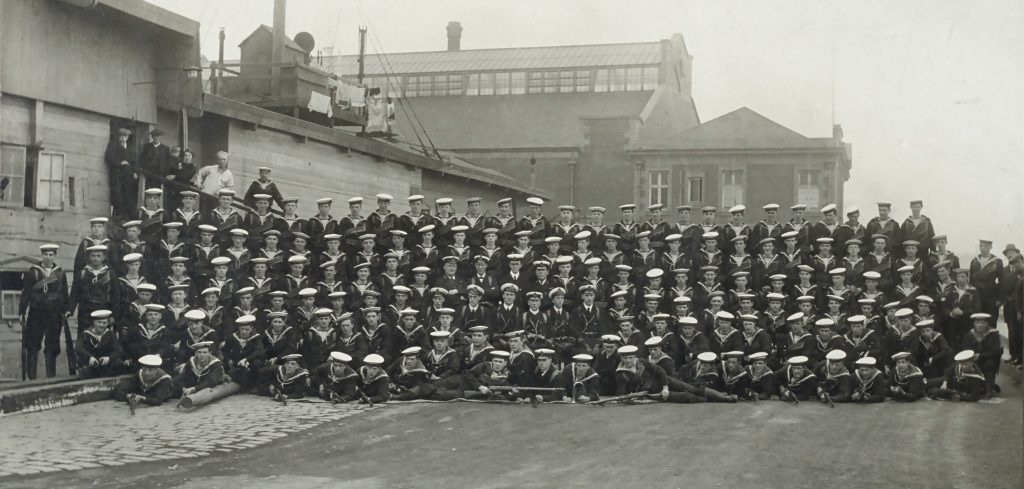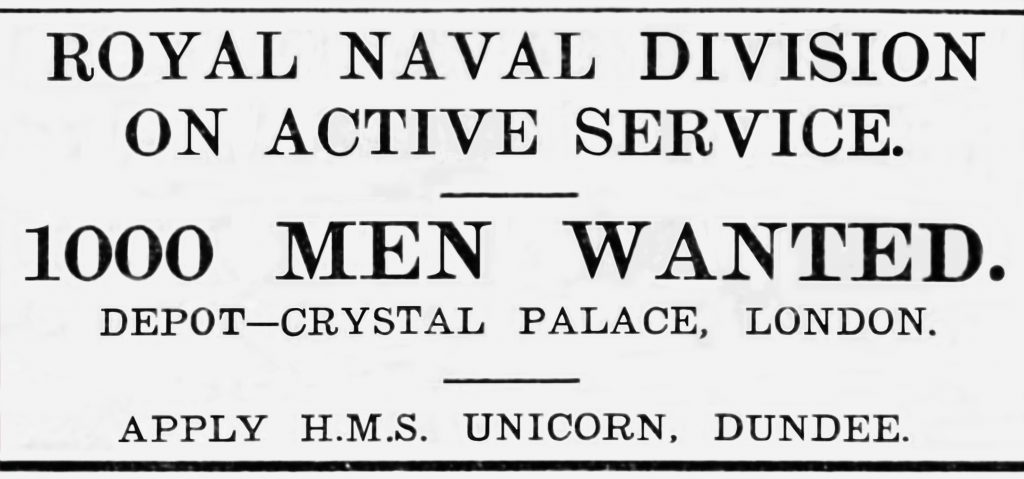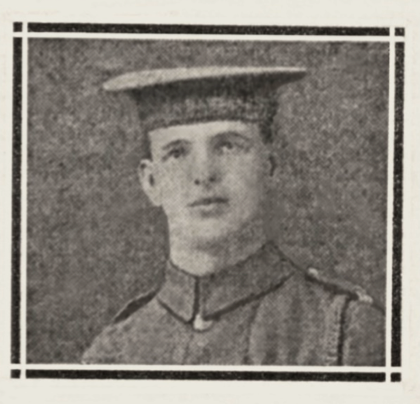Great War Dundee
This is Dundee's story of those that served in the First World War, and of the people left at home
- At the Front
- Dundee’s Own
- Battle of Loos
- Ranks, roles and jobs
- Daily life at the front
- The War at Sea
- HMS Vulcan and the 7th Submarine Flotilla
- ‘Dundee Ladies Drowned.’ U-boats and Surface Raiders
- ‘Every shot was a hit!’ HMS Dundee and the North Sea Blockade
- ‘Engaged submarine with gunfire.’ HMS Perth and the Red Sea Patrol
- Sea Soldiers. HMS Unicorn and the Royal Naval Volunteer Reserve
- North Sea Patrol. Royal Naval Air Station Dundee
- Commemoration. The Roll of Honour and Seamens’ Memorial
- Letters to and from home
- Dundee facts about WW1
- 5 myths of WW1
- Brave Animals
- Cemeteries and memorials worldwide
Sea Soldiers. HMS Unicorn and the Royal Naval Volunteer Reserve

When war broke out in 1914 the Dundee Company of the Royal Naval Volunteer Reserve (RNVR) based in the Georgian man o’ war drill ship HMS Unicorn numbered over 200 officers and ratings complete with a thirty-strong silver band. Many were speedily drafted straight into sea service, but the 157 officers and ratings who marched to Taybridge Station on a balmy evening in August 1914 were on their way to camps in the south of England. There they were to join the Royal Naval Division and train to fight as infantrymen.
Stirring scenes were witnessed at Taybridge Station last evening when a large detachment of the Royal Naval Volunteer Reserve (Clyde Division) took their departure.
The men were under the command of Lieut. Still, and a very fit and hardy body they looked as they marched with swinging step from the drill ship, HMS Unicorn, to the station. The band marched at the head of the column playing a popular air. A big crowd cheered the handymen loudly…the boys in blue were in high spirits, and they answered the cheers of the crowd in their own ‘sea dog’ fashion.
Dundee Courier, 22 August 1914

There was nothing new in sailors fighting as soldiers on land; Bluejackets and Royal Marines had served ashore during the 1898 Omdurman campaign, the 1900 Boxer rebellion and the 1899-1902 Boer War. But when the barely half-trained Dundee reservists, still wearing navy blue and armed only with obsolete rifles, were thrown into the defence of Antwerp in October 1914, they faced a professional German Army equipped with heavy artillery, mortars, machine guns and Zeppelin airships. It was, unsurprisingly, a one-sided affair. Nevertheless, it bought the Allies a vital few days in which to establish a defensive line that saved the Channel ports of Dunkerque and Calais, vital if Britain was to maintain an army on the Western Front.
Dundee’s Antwerp veterans, among them 14-year-old Able Seaman Murray McDougall, the second youngest ‘Old Contemptible’ British serviceman to serve on the Western Front in 1914, returned to find recruiting already under way aboard HMS Unicorn for a greatly expanded Royal Naval Division of eight battalions. More than two thousand men from Dundee and the surrounding area would board Dundee’s Georgian man o’ war to join the RND by the time the war ended in 1918.

Fighting amid the bloody shambles of Gallipoli with no artillery, pitifully few machine guns, obsolete rifles, no mortars or grenades and woefully inadequate medical facilities, the RND suffered terrible losses. At the Third Battle of Krithia on 4 June 1915, the Collingwood Battalion went into action over 800 strong and, in just forty minutes, suffered 625 dead, wounded and missing. Among the battalion’s dead was 19-year-old Leading Seaman David Strathern from Lorimer Street in Dundee. Like so many on that horrific afternoon, David (right) had to be left on a battlefield swept by Turkish machine guns and posted as missing. For his distraught family, this meant months of uncertainty as they desperately tried to find out what had happened.
In December 1915, six months after the battle, Able Seaman Tom Murphy was able tell the Stratherns that, ‘I saw him fall alongside of Lieut. Freyberg, and he did not turn up after roll-call, and I never heard of him since.’ There remained the faint hope that David had been wounded and taken prisoner, but an approach to the Turkish Foreign Office by the still neutral American embassy in Constantinople brought no new information. Finally, in May 1916, a full year after the Krithia battle, Lieutenant Edward Ellis of the RND Howe Battalion reported that David Strathern’s remains had been seen during an Allied advance in August 1915, but not recovered for burial.
The Collingwood Battalion was never reformed, but in May 1916 Dundee’s ‘Sea Soldiers’ were transferred with the rest of the RND to the Western Front and were incorporated into the British Army as the 63rd (Royal Naval) Division. They played key roles in the grim battles of Arras, Passchendaele and Cambrai, and they were at the forefront in the fast-moving Hundred Days campaign that ended the war in 1918. Many who had fought in the Gallipoli trenches had meanwhile reverted to the RNVR and won new honours battling U-boats in the Western Approaches.
The record of the Royal Naval Division and of the Dundee Sea Soldiers who fought in it is second to none. Indeed, many who fought in the Gallipoli trenches subsequently reverted to the RNVR and won new honours battling U-boats in the Western Approaches.

Research carried out by Great War Dundee and HMS Unicorn has identified 295 Sea Soldiers of the Royal Naval Division from Angus, Dundee Perth and Fife who lost their lives. Just one among them was Petty Officer Harry Chalmers (right), shot and killed during the Battle of the Ancre on 13 November 1917. Another was Able Seaman Victor Ferrar, a bandsman and stretcher-bearer from Perth Road in Dundee. Victor was shot and killed by a Turkish sniper during a desperate and immensely brave solo mission to carry aid to a wounded man trapped in no-man’s-land. He was just 17 years of age.
Alongside her role as a recruiting centre for the RND which saw around 2,500 men enlist aboard the old ship, HMS Unicorn also served throughout the war as the headquarters of the Senior Naval Officer, Dundee. She reverted to her role as RNVR drill ship between the wars before once again serving as a naval headquarters in the Second World War. Today, she is a museum ship berthed in Victoria Dock, Dundee.
